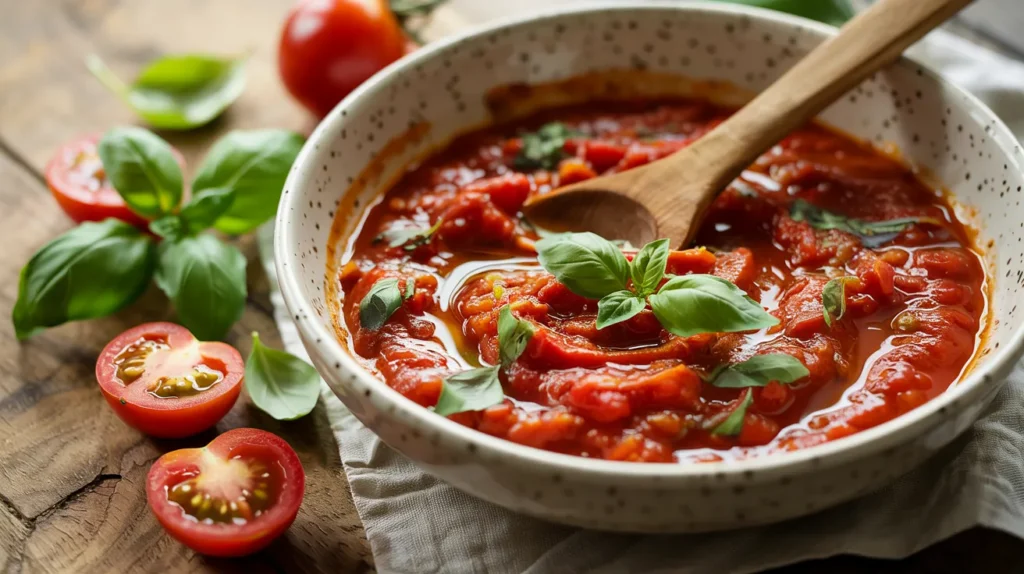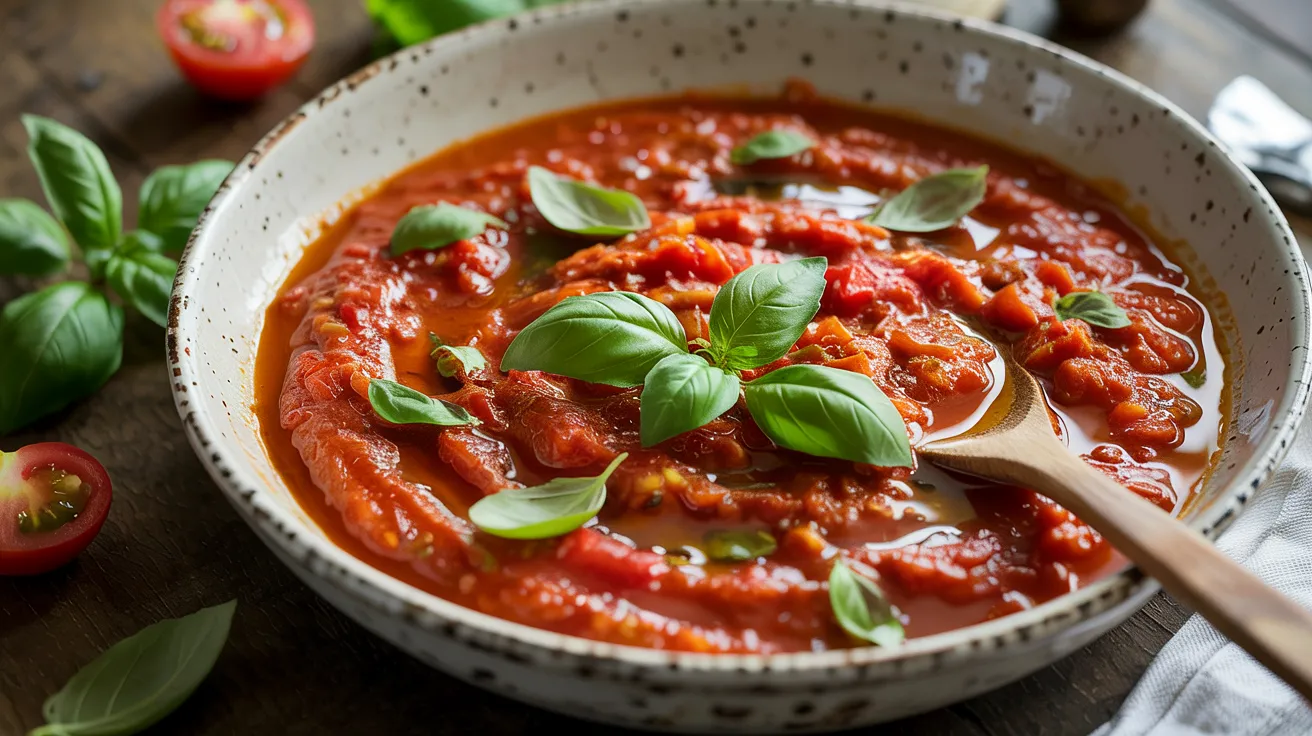Prep Time: 10 minutes | Cook Time: 20 minutes | Total Time: 30 minutes | Servings: 4
Key Takeaways
- This classic Homemade Pomodoro Sauce requires just 6 basic ingredients
- The secret is using high-quality San Marzano tomatoes
- Perfect for pasta, pizza, or as a dipping sauce
- Freezes beautifully for quick weeknight meals
Why Make Homemade Pomodoro Sauce?
Ever grabbed a jar of store-bought pasta sauce only to taste that flat, overly sweet flavor? Not great.
Here’s the solution: this simple Homemade Pomodoro Sauce takes just 30 minutes but tastes like it simmered all day. The bright tomato flavor and fresh herbs will change your pasta game forever.
This sauce isn’t just quick – it’s restaurant quality. Once you master this basic Homemade Pomodoro Sauce, you’ll wonder why you ever bought the jarred stuff.
Let’s compare how this recipe stacks up against store-bought options:
Nutrition Comparison
| Nutrient | Homemade Pomodoro Sauce (per serving) | Store-Bought Sauce (per serving) |
|---|---|---|
| Calories | 105 | 130-180 |
| Sodium | 320mg | 480-750mg |
| Sugar | 4g (natural) | 8-12g (often added) |
| Preservatives | None | Several |
| Cost | $1.25-$1.75 per serving | $0.85-$2.50 per serving |
What You’ll Need
Ingredients
| Ingredient | Amount | Notes |
|---|---|---|
| San Marzano tomatoes (canned, whole) | 28 oz can | Can substitute high-quality plum tomatoes |
| Fresh garlic | 4 cloves, minced | Not pre-minced from jar |
| Extra virgin olive oil | 3 tablespoons | Use good quality |
| Fresh basil leaves | 8-10 leaves, plus more for garnish | Torn, not chopped |
| Salt | 1 teaspoon | Kosher or sea salt preferred |
| Sugar | ¼ teaspoon | Optional, balances acidity if needed |
| Red pepper flakes | ¼ teaspoon | Optional, for heat |
| Yellow onion | ½ small, finely diced | Optional for added depth |
Kitchen Tools
| Tool | Purpose |
|---|---|
| Heavy-bottomed pot or Dutch oven | Provides even heating |
| Wooden spoon | Won’t react with acidic tomatoes |
| Immersion blender or food processor | For smoothing sauce |
| Sharp chef’s knife | For garlic and basil |
| Cutting board | Prep surface |
| Can opener | For tomatoes |
| Fine mesh strainer | Optional for silky smooth texture |
Substitutions
If you don’t have some ingredients on hand, here are some swaps that work:
- Fresh basil → 1 tablespoon dried basil (add during cooking, not at end)
- San Marzano tomatoes → Regular canned whole tomatoes (may need to adjust sugar)
- Fresh garlic → 1 teaspoon garlic powder (less flavor but works in a pinch)
- Yellow onion → White onion or shallot
Step-by-Step Instructions
Preparation Phase
- Set up your workspace:
- Clear your counter space completely.
- Place your cutting board in the center of your workspace.
- Keep a clean kitchen towel nearby for wiping hands.
- Fill a small bowl with water to rinse your fingers if they get sticky from handling ingredients.
- Gather all ingredients:
- Take out all ingredients and place them on the counter.
- Check that you have everything listed in the ingredients section.
- Measure out all ingredients before starting to cook.
- Set aside in small bowls or measuring cups.
- Prepare the garlic:
- Place 4 cloves of garlic on your cutting board.
- Use the flat side of your knife to gently crush each clove (press down with your palm).
- Remove the papery skin completely.
- Cut off the hard end where the clove was attached to the head.
- Slice each clove lengthwise into thin slices.
- Then cut across the slices to create very small pieces (about 1mm in size).
- BEGINNER TIP: Don’t worry if your pieces aren’t perfectly even. Just aim for small pieces so they cook evenly.
- Prepare the onion (if using):
- Cut the onion in half from top to bottom.
- Peel off the papery outer layer.
- Place one half flat-side down on your cutting board (save the other half for another use).
- Make vertical cuts from top to bottom, about ¼-inch apart, but don’t cut all the way through the root end.
- Then make horizontal cuts parallel to the board, also ¼-inch apart.
- Finally, slice across the onion to create small diced pieces.
- BEGINNER TIP: If your eyes tear up, try refrigerating the onion for 15 minutes before cutting or running it under cold water.
- Prepare the basil:
- Gently rinse basil leaves under cold water.
- Pat completely dry with paper towels or a clean kitchen towel.
- Stack 8-10 leaves on top of each other.
- Using your fingers (not a knife), tear the basil into small pieces.
- BEGINNER TIP: Tearing rather than cutting helps prevent the basil from bruising and turning black.
- Prepare the tomatoes:
- Open the can of San Marzano tomatoes.
- Pour the entire contents (tomatoes and juice) into a large bowl.
- BEGINNER TIP: Some San Marzano tomatoes have a thin strip of basil in the can – you can leave this in.
Cooking Phase
- Heat your pot:
- Place your heavy-bottomed pot or Dutch oven on the stove.
- Set heat to medium (not medium-high, just medium).
- Allow the pot to heat up for about 30 seconds.
- BEGINNER TIP: To test if the pot is hot enough, sprinkle a few drops of water on it – they should sizzle gently.
- Add the oil:
- Pour 3 tablespoons of extra virgin olive oil into the pot.
- Tilt the pot to ensure the oil coats the bottom evenly.
- Wait about 30-60 seconds until the oil shimmers slightly.
- BEGINNER WARNING: If you see smoke rising from the oil, it’s too hot! Remove from heat briefly, then return to burner at a lower setting.
- Cook the garlic (and onion if using):
- Add the minced garlic to the oil.
- Immediately begin stirring with your wooden spoon.
- Keep stirring constantly for 30-45 seconds.
- The garlic should become fragrant and just slightly golden (not brown).
- BEGINNER WARNING: Garlic burns very quickly! Watch it carefully and keep stirring. If it starts to turn dark brown, lower heat immediately.
- If using onion, add it now and cook for 3-4 minutes, stirring frequently, until translucent.
- Add red pepper flakes (if using):
- Sprinkle ¼ teaspoon red pepper flakes over the garlic and oil.
- Stir for 10 seconds to infuse the oil.
- BEGINNER TIP: For milder heat, use just a pinch instead of the full ¼ teaspoon.
- Add the tomatoes:
- Pour the entire bowl of tomatoes (with their juice) into the pot.
- Be careful as it might splatter a little.
- Using your wooden spoon, gently crush each tomato against the side of the pot.
- Take your time with this step and crush every tomato until no large pieces remain.
- BEGINNER TIP: You want some texture, so don’t worry about getting them completely smooth.
- Season the sauce:
- Add 1 teaspoon salt, sprinkling it evenly across the surface of the sauce.
- If using sugar, add ¼ teaspoon now.
- Stir everything together thoroughly.
- BEGINNER TIP: Salt helps draw out flavor from the tomatoes. Don’t skip this step!
- Simmer the sauce:
- Increase heat to medium-high until the sauce begins to bubble gently.
- Once bubbling, immediately reduce heat to medium-low.
- The sauce should be gently simmering with small bubbles breaking the surface occasionally.
- Leave the pot uncovered.
- Set a timer for 15 minutes.
- Stir the sauce every 3-4 minutes to prevent sticking.
- BEGINNER TIP: If sauce bubbles too vigorously, lower the heat. If it’s not bubbling at all, slightly increase heat.
- Check for thickening:
- After 15 minutes, check the sauce consistency.
- Drag your wooden spoon through the sauce – it should leave a brief trail before filling back in.
- If still very watery, continue simmering for 5 more minutes.
- BEGINNER TIP: The sauce will thicken slightly as it cools, so don’t over-reduce it.
- Adjust the texture (optional):
- For a chunky sauce: Leave as is.
- For a smooth sauce: Turn off heat. Let cool for 2 minutes.
- If using immersion blender: Insert it into the pot and pulse 5-6 times, moving around the pot. Don’t completely purée.
- If using food processor: Carefully transfer sauce to food processor. Pulse 5-6 times. Return to pot.
- For extra-smooth sauce: Strain through fine mesh strainer, using the back of a ladle to push it through.
- BEGINNER WARNING: Be extremely careful with hot sauce and blenders. Steam can cause pressure to build up.
Finishing Touches
- Final seasoning:
- Turn off the heat completely.
- Taste the sauce using a clean spoon.
- If it needs more salt, add ¼ teaspoon at a time, stirring and tasting after each addition.
- BEGINNER TIP: The sauce should taste slightly stronger than you want the final product, as the flavor will mellow when added to pasta.
- Add the fresh basil:
- Sprinkle the torn basil leaves over the sauce.
- Gently stir them in.
- BEGINNER TIP: Adding basil at the end preserves its fresh flavor and bright green color.
- Final oil drizzle:
- Drizzle about 1 tablespoon of fresh extra virgin olive oil over the surface of the sauce.
- Give it one gentle stir.
- BEGINNER TIP: This adds a fresh olive oil flavor that elevates the finished sauce.
- Rest before serving:
- Let the sauce sit off heat for 5 minutes.
- This allows the flavors to meld together.
- Stir once more before serving.
How to Use Your Homemade Pomodoro Sauce
This versatile sauce works beautifully with:
- Pasta (especially spaghetti or penne)
- As pizza sauce (reduce slightly longer for thicker consistency)
- For dipping garlic bread or breadsticks
- As a base for baked eggs (shakshuka-style)
- Over chicken or eggplant parmesan

Troubleshooting
| Problem | Cause | Solution |
|---|---|---|
| Sauce too watery | Not cooked long enough | Simmer 5-10 minutes longer uncovered |
| Sauce too acidic | Tomato variation | Add ¼ teaspoon more sugar |
| Sauce too thick | Cooked too long | Add 2-3 tablespoons pasta water or broth |
| Bitter taste | Burned garlic | Next time, watch garlic carefully; for now, add pinch of sugar and splash of cream |
| Bland flavor | Insufficient seasoning | Add salt gradually (¼ tsp at a time); consider adding Parmesan rind next time |
Variations & Substitutions
Want to mix it up? Try these easy variations for different flavor profiles:
Spicy Pomodoro
Add ½ teaspoon red pepper flakes and increase garlic to 6 cloves
Creamy Pomodoro
Stir in ¼ cup heavy cream after removing from heat
Roasted Garlic Pomodoro
Substitute regular garlic with 1 head of roasted garlic
Herb-Garden Pomodoro
Add 1 teaspoon each of fresh oregano, thyme, and rosemary along with the basil
To learn more about how pomodoro sauce fits into the classic sauce hierarchy and basic techniques, check out our guide to foundation sauces. For a unique color variation, try our bright and sunny Golden Yellow Tomato Sauce that uses yellow tomatoes for a naturally sweeter flavor.
Storage & Reheating
Refrigerator Storage:
- Cool sauce completely (about 30-45 minutes)
- Transfer to airtight container
- Refrigerate up to 5 days
- BEGINNER TIP: Don’t put hot sauce directly in the refrigerator as it raises the interior temperature.
Freezer Storage:
- Cool sauce completely
- Portion into freezer-safe containers or ice cube trays
- Leave ½-inch headspace for expansion
- Seal tightly, removing as much air as possible
- Label with date and contents
- Freeze for up to 3 months
- BEGINNER TIP: Ice cube trays work great for small portions that can be defrosted individually.
Reheating Instructions:
From refrigerator:
- Pour sauce into saucepan
- Heat over medium-low heat
- Stir occasionally to prevent sticking
- Heat for 5-8 minutes until bubbling gently
- BEGINNER TIP: Adding a splash of water helps loosen refrigerated sauce.
From frozen:
- Thaw overnight in refrigerator (safest method)
- Or defrost in microwave using “defrost” setting
- Transfer to saucepan and heat as above
- BEGINNER WARNING: Never thaw at room temperature for safety reasons.
Safety Notes & Tips
- Temperature safety: Sauce should reach at least 165°F (74°C) when cooking
- Cooling safety: Don’t leave sauce at room temperature for more than 2 hours
- Meal prep tip: Make double batch and freeze half for future meals
- Flavor enhancer: For deeper flavor, add a small piece of Parmesan cheese rind during simmering
- Consistency tip: If you prefer a thicker sauce, similar to our homemade marinara sauce, simply simmer for an additional 10 minutes
Expert Tips
- Use whole tomatoes, not crushed or pureed, for best texture
- Don’t rush the simmering – this develops flavor
- Add basil at the end to preserve its fresh flavor
- Taste before serving and adjust seasoning
- Cold oil, hot pan prevents sticking and burning
- Save some pasta water when boiling pasta – the starchy water helps sauce cling to pasta
Now you’re ready to create the perfect Homemade Pomodoro Sauce that will impress family and friends. The simple ingredients let the tomato flavor shine, creating a sauce that’s both rustic and refined.




